Smart Forest Modeling Behavioral for a Greener Future: An AI Text-by-Voice Blockchain Approach with Citizen Involvement in Sustainable Forestry Functionality
Abstract
1. Introduction
2. Materials and Methods
2.1. Tree CAD Modeling—Blockchain Integration Method
2.2. Personalized CAD Software (Event-Driven Procedures)
- (i).
- The tree-frame’s CAD “adverbs” LV, CO, LC, and WT are predefined.
- (ii).
- For generic geo-referencing modeling, the GRP is assigned to coordinates 0.0, 0.0, 0.0 (tree modeling universe space) (Figure 2).
- (iii).
- In the FRONT view of the host CAD platform a tree-frame is designed according to the tree’s height and width1 parameters (Height, Width1) (Figure 2).
- (iv).
- In the RIGHT view of the host CAD platform another tree-frame is designed according to the tree’s height and width2 parameters (Height, Width2) (Figure 3).
- (v).
- The last tree-frame is relocated in such a way that both frames cross each other perpendicularly. In this way compound tree-frame is constructed (Figure 3).
- (vi).
- (vii).
- Four tree’s scalable raster images (jpg format), obtained from a user’s noise-free photography (such as a smartphone jpg picture), are assigned to these four tree-frames (as the unique geometry located in level LV and colored with color CO) using a user-defined GUI’s dialog setting box, in accordance with the predefined level (LV) and color (CO) parameters after the tree’s geometry construction, as well as for tree-leaves texture and color-imagery assignment (Figure 4, Figure 5 and Figure 6). In this manner, the GRP (0.0, 0.0, 0.0) is used to create a 4-images compound tree frame for a metaverse smart forest (Figure 7).
- (viii).
- (ix).
- (x).
- The tangible tree-model NFT is deployed step by step (i.e., wallet setup → tangible token creation → token addition to a thematic metaverse sustainable forestry blockchain) (Figure 13).
2.3. Batch Command-Line Programming (The Adverbs-VERB-Nouns Metaphor)
3. Results
3.1. “Internet-of-Tree Models” Blockchain: The Outline Design
- Hash-01 = hash (Hash-0 & Hash-1)
- Hash-23 = hash (Hash-2 & Hash-3)
- Notes
- The cryptographic algorithm SHA256 has been employed for the hashing (hash values Hash-0, Hash-1, Hash-2, Hash-3, Hash-01, and Hash-23).
- “Block 0” or the “genesis block” is the initial "IoTr-model" block that has been the foundation for the subsequent blocks in the suggested chain. This block, known as the fundamental block, serves as the starting point for the “IoTr-models” thematic blockchain (tree-model NFT tokens ledger).
3.2. Comparative Validation Analysis—Usability Test
- (i).
- Overestimation for small AGB values (<60 Mg/ha) and underestimation for large AGB values (>400 Mg/ha) are serious issues when using laser scanning, and terrestrial or close-range photogrammetry.
- (ii).
- Compared to the suggested “IoTr-models” technique, which yields AGB estimations of roughly 97 Mg/ha, drone photogrammetry footage yields more accurate estimates (RMSE values of about 25 Mg/ha).
- (iii).
- (iv).
- When AGB > 600 Mg/he, stratification based on forest types improved AGB estimation by using the proposed “Voice-to-text IoTr-models” technique. Hence, the proposed technique provides new insight into AGB modeling [20].
- (v).
- (vi).
- By utilizing an ASCII text editor to change the batch file, the end-user can alter the entire process offline and outside of the CAD environment, with the interpretation batch file at the client level (Figure 13). The change can be made offline (i.e., outside of a CAD platform software), with AI functionality, and without stress or the possibility of a design mishap [8,9,11,19].
3.3. Integrating Financial Theories
3.3.1. Carbon Credit Valuation
3.3.2. Token-Based Incentives
3.3.3. Behavioral Finance
3.3.4. ESG (Environmental, Social, Governance) Integration
3.3.5. Market Mechanisms
4. Discussion
4.1. Behavioral Model with Blockchain Functionalities
- Data Integrity and Confidence: Blockchain ensures cryptographic data security for tree geometry and AGB texture, preventing unauthorized modifications and ensuring reliable data for decision-making.
- Transparency: The blockchain records all transactions, such as changes in tree geometry growth and leaf texture, in a distributed ledger. This allows stakeholders to access and verify data without relying on central authority.
- Collaborative Design and Monitoring: Blockchain facilitates decentralized and autonomous design, enabling multiple stakeholders to share the same data and collaborate effectively in forestry management.
- Smart Contracts: Self-executing agreements between clients and designers can automate processes, reduce human error, and enhance trust in forestry management operations.
- Controlled Scaling: The “Merkle hash tree” structure in blockchain allows for simple and controlled scaling, making it easier to manage large datasets related to forestry.
4.2. AI-Driven Voice-to-Text Technique
- Automation and efficiency: The technique converts predefined human oral phrases (e.g., “place point,” “rotate”) into text sequences that are automatically transcribed into CAD commands. This eliminates the need for manual input, speeding up the design process and reducing human error.
- Cost and time savings: By automating CAD programming tasks, the technique reduces the time, resources, and money required for point-by-point design, making it a low-cost solution for tree modeling and landscape architecture.
- Flexibility in design: The vector parametric modeling enabled by text-by-voice commands allows for geometric transformations such as move, rotate, scale, and mirror. This flexibility enhances the functionality and adaptability of CAD designs.
- User-friendly interface: Simple English phrases are used as commands, making the technique accessible to users with varying levels of technical expertise. This lowers the barrier to entry for CAD programming.
- Offline operation: The text-by-voice technique supports offline CAD programming, allowing users to work in a relaxed and error-free environment without requiring constant internet connectivity.
- Integration with blockchain: The technique facilitates the creation of tangible tree-model NFT tokens and their integration into the “Internet-of-Trees” blockchain. This adds value to CAD designs by enabling decentralized and collaborative monitoring.
- Batch command-Line programming: The technique generates personalized key-in commands nested in a batch command ASCII text file. This allows for efficient execution of event-driven routines, further enhancing the scalability and usability of CAD programming.
- Enhanced planning intelligence: The automated process supports real-time planning intelligence, making it suitable for applications like smart forest monitoring, landscape architecture, and collaborative design.
4.3. Research Questions
- Forest Metaverse Monitoring Improvements
- Citizen Involvement in Sustainable Forestry
4.4. Outcome
- (i).
- A simple 2.5D parametric and relative tree CAD modeling methodology has been described for tangible tree-models as NFT tokens that guarantees uniqueness through a hash (metaverse IoTr-models thematic blockchain), enabling distributed design and collaborative metaverse monitoring for trees and smart forests where high tree-modeling accuracy is not required; and
- (ii).
- A clever, secure, simple, and error-free “Voice-to-text batch command-line programming” tree modeling approach has been implemented, using simple English language phrases as command-line commands for dedicated key-ins hooking and the IoTr-models metaverse thematic blockchain.
- (iii).
- Ability for citizen involvement in sustainable forestry using off-the-shelf equipment and software like smartphones and metaverse-supported apps.
4.5. Findings
- (i)
- Experimental data (findings) showed that the proposed strategy performed satisfactorily in terms of tree shape modeling when compared to manual terrestrial laser scanning or drone/terrestrial/close-range photogrammetry approaches.
- (ii)
- Parallel design, same-data sharing, and coordinated design -also known as decentralized and autonomous design efficiency- are made easier by the proposed technique.
- (iii)
- A batch file with simple ASCII plain-text commands can serve as an interpretation tool for the IoTr-models thematic blockchain case study, allowing for real-time tree modeling operations in a safe, relaxed, and error-free offline metaverse environment with flexibility in planning, design, and redesign.
4.6. Robustness, Scalability, and Metaverse Applications
- Robustness
- Scalability
- Metaverse applications
4.7. CAD Integration
- Efficient tree modeling: CAD platforms enable the creation of parametric tree models using predefined routines, eliminating the need for costly and time-consuming point-by-point designs. This enhances the efficiency of forest monitoring systems.
- Scalable modeling: CAD integration allows for scalable tree modeling, where tree dimensions, color, and texture can be easily adjusted. This flexibility supports large-scale forest monitoring and planning.
- Automated processes: The use of text-by-voice CAD programming automates the generation of 2.5D tree models and their integration into metaverse monitoring systems, reducing human error and saving time.
- Blockchain integration: CAD platforms facilitate the creation of tangible tree-model NFT tokens, which can be added to a blockchain for secure and decentralized monitoring. This ensures data integrity and collaborative design.
- Visualization and analytics: CAD tools provide advanced visualization capabilities, such as architectural lighting and fly-through functionality, enabling better data analytics, metaverse analysis, and digital documentation of forest landscapes.
- Cost and time efficiency: Compared to traditional methods like terrestrial laser scanning or drone photogrammetry, CAD-Blockchain integration offers a low-cost and time-efficient solution for metaverse forest monitoring.
4.8. NFT Tokens Protection
- Unique tree identification: NFT tokens provide a unique digital representation of individual trees or forest landscapes, ensuring precise tracking and documentation.
- Data integrity: NFTs are stored on a blockchain, making the data immutable and tamper-proof. This ensures the reliability of tree-related information, such as geometry growth and texture changes.
- Scalability: NFT tokens allow for scalable forest monitoring and management, enabling the tracking of large numbers of trees in a decentralized manner.
- Collaborative design: NFTs facilitate distributed and collaborative forestry management, allowing multiple stakeholders to contribute to and validate data in real-time.
- Cost efficiency: Compared to traditional methods like laser scanning or photogrammetry, NFT-based systems are more cost-effective and time-efficient.
- Integration with blockchain: NFTs enable seamless integration with blockchain technology, supporting smart contracts, decentralized planning, and secure data sharing.
- Metaverse projects and applications: NFT tokens can be used in virtual reality or metaverse environments for immersive forest simulations and advanced planning intelligence.
- Environmental impact: By improving monitoring and management, NFTs contribute to sustainable forestry practices and a greener future.
4.9. Limitations
4.10. Suggestions for Improvements and Further Study
5. Conclusions
Author Contributions
Funding
Institutional Review Board Statement
Informed Consent Statement
Data Availability Statement
Acknowledgments
Conflicts of Interest
References
- Dimitriadis, K.A.; Koursaros, D.; Savva, C.S. Exploring the Dynamic Nexus of Traditional and Digital Assets in Inflationary Times: The Role of Safe Havens, Tech Stocks, and Cryptocurrencies. Econ. Model. 2025, 151, 107195. [Google Scholar] [CrossRef]
- Liu, J.; Wan, J.; Li, S.; Shen, Y.; Han, W.; Liu, G. Spatial–Temporal Pattern of Coordination between the Supply and Demand for Ecosystem Services in the Lhasa River Basin. Land 2024, 13, 510. [Google Scholar] [CrossRef]
- Peng, R.; Zeng, B. Digital Financial Inclusion and Inclusive Green Growth: Evidence from China’s Green Growth Initiatives. Int. J. Financ. Stud. 2025, 13, 2. [Google Scholar] [CrossRef]
- McCormick, K.; Anderberg, S.; Coenen, L.; Neij, L. Advancing Sustainable Urban Transformation. J. Clean. Prod. 2013, 50, 1–11. [Google Scholar] [CrossRef]
- Varveris, D.; Styliadis, A.; Xofis, P.; Dimen, L. Tree Architecture & Blockchain Integration: An off-the-shelf Experimental Approach. WSEAS Trans. Environ. Dev. 2023, 19, 969–977. [Google Scholar] [CrossRef]
- Brandín, R.; Abrishami, S. IoT-BIM and blockchain integration for enhanced data traceability in offsite manufacturing. Autom. Constr. 2024, 159, 105266. [Google Scholar] [CrossRef]
- Sharma, R.P.; Vacek, Z.; VacekA, S.; Kučera, M. Modelling individual tree height–diameter relationships for multi-layered and multi-species forests in central Europe. Trees 2019, 33, 103–119. [Google Scholar] [CrossRef]
- Yazdi, H.; Shu, O.; Ferdinand, L. A Target-driven Tree Planting and Maintenance Approach for Next Generation Urban Green Infrastructure (UGI). J. Digit. Landsc. Archit. 2023, 8, 178–185. [Google Scholar] [CrossRef]
- Fox, N.; Lidquist, M.; Berkel, V.D.; Vergel, R.S. A Collaborative Augmented Reality Decision Support System for Crowdsourcing Urban Designs. J. Digit. Landsc. Archit. 2023, 8, 195–202. [Google Scholar] [CrossRef]
- Li, D.; Jia, W.; Guo, H.; Wang, F.; Ma, Y.; Peng, W.; Zhang, S. Use of terrestrial laser scanning to obtain the stem diameters of Larix olgensis and construct compatible taper-volume equations. Trees 2023, 37, 749–760. [Google Scholar] [CrossRef]
- Ma, Y.; Brindley, P.; Lange, E. A Comparison of GIS-based Methods for Modelling Walking Accessibility of Parks in Guangzhou Considering Different Population Groups. J. Digit. Landsc. Archit. 2022, 7, 269–279. [Google Scholar] [CrossRef]
- Lemeš, S.; Lemeš, L. Blockchain in Distributed CAD Environments. In New Technologies, Development and Application II; Karabegovic, I., Ed.; Springer Nature: Berlin/Heidelberg, Germany, 2020; pp. 25–32. [Google Scholar] [CrossRef]
- Altun, C.; Tavli, B.; Yanikomeroglu, H. Liberalization of digital twins of IoT-enabled home appliances via blockchains and absolute ownership rights. IEEE Commun. Mag. 2019, 57, 65–71. [Google Scholar] [CrossRef]
- Liu, M.; Guo, T.; Ping, W.; Luo, L. Sustainability and stability: Will ESG investment reduce the return and volatility spillover effects across the Chinese financial market? Energy Econ. 2023, 121, 106674. [Google Scholar] [CrossRef]
- Rosário, A.T.; Lopes, P.R.; Rosário, F.S. How Digital Development Leverages Sustainable Development. Sustainability 2025, 17, 6055. [Google Scholar] [CrossRef]
- Dounas, T.; Lombardi, D. A CAD-blockchain integration strategy for distributed validated digital design. In eCAADe 2018: Computing for a Better Tomorrow, Proceedings of the 36th International Conference on Education and Research in Computer Aided Architectural Design in Europe (eCAADe 2018), Lodz, Poland, 19–21 September 2018; Kępczyńska-Walczak, A., Bialkowski, S., Eds.; CumInCAD: Hong Kong, China, 2018; Volume 1, pp. 223–230. Available online: http://papers.cumincad.org/cgi-bin/works/paper/ecaade2018_226 (accessed on 5 July 2025).
- Dimitriadis, K.A.; Koursaros, D.; Savva, C.S. The influence of the “environmental-friendly” character through asymmetries on market crash price of risk in major stock sectors. J. Clim. Financ. 2024, 9, 100052. [Google Scholar] [CrossRef]
- Liyanaarachchi, G.; Viglia, G.; Kurtaliqi, F. Addressing challenges of digital transformation with modified blockchain. Technol. Forecast. Soc. Change 2024, 201, 123254. [Google Scholar] [CrossRef]
- Xudong, Z.; Lin, S.; Qi, J.; Yok, T.P. Linking Image-based Metrics to 3D Model-based Metrics for Assessment of Visual Landscape Quality. J. Digit. Landsc. Archit. 2023, 8, 167–177. [Google Scholar] [CrossRef]
- Xofis, P.; Spiliotis, J.A.; Chatzigiovanakis, S.; Chrysomalidou, A.S. Long-Term Monitoring of Vegetation Dynamics in the Rhodopi Mountain Range National Park—Greece. Forests 2022, 13, 377. [Google Scholar] [CrossRef]
- Kukman, T.; Gricar, S. Blockchain for Quality: Advancing Security, Efficiency, and Transparency in Financial Systems. FinTech 2025, 4, 7. [Google Scholar] [CrossRef]
- Michail, N.A.; Savva, C.S.; Koursaros, D. Side Effects of Fiscal Policy and Business Confidence in the Euro Area. Int. J. Financ. Stud. 2017, 5, 26. [Google Scholar] [CrossRef]
- Basdekidou, V.A.; Papapanagos, H. The Use of DEA for ESG Activities and DEI Initiatives Considered as “Pillar of Sustainability” for Economic Growth Assessment in Western Balkans. Digital 2024, 4, 572–598. [Google Scholar] [CrossRef]
- Dezio, C.; Zhang, C.; Zhang, Y.; Marino, D. The Role of Landscape Design in Cultural Rural Areas. A Didactic Exercise to Experiment a Research-by-Design Process Applied to an Italian UNESCO Wine Site. Architecture 2021, 1, 117–139. [Google Scholar] [CrossRef]
- Sadri, H.; Yitmen, I.; Tagliabue, L.C.; Westphal, F.; Tezel, A.; Taheri, A.; Sibenik, G.J.S. Integration of blockchain and digital twins in the smart built environment adopting disruptive technologies—A systematic review. Sustainability 2023, 15, 3713. [Google Scholar] [CrossRef]
- Hellenborn, B.; Eliasson, O.; Yitmen, I.; Sadri, H. Asset information requirements for blockchain-based digital twins: A data-driven predictive analytics perspective. Smart Sustain. Built Environ. 2023, 13, 22–41. [Google Scholar] [CrossRef]
- Seyedkolaei, A.A.; Mahmoudi, F.; García, J. A Deep Learning Approach for Multiclass Attack Classification in IoT and IIoT Networks Using Convolutional Neural Networks. Future Internet 2025, 17, 230. [Google Scholar] [CrossRef]
- Rahman, A.; Khan, M.; Attom, B.; Manoharan, M. Advanced Data Analytics in Green Finance: Blockchain and Digital Twin Integration. In Harnessing Blockchain-Digital Twin Fusion for Sustainable Investments; IGI Global Scientific Publishing: Hershey, PA, USA, 2024; p. 24. [Google Scholar] [CrossRef]
- Fu, H.; Li, H.; Dong, Y.; Xu, F.; Chen, F. Segmenting Individual Tree from TLS Point Clouds Using Improved DBSCAN. Forests 2022, 13, 566. [Google Scholar] [CrossRef]
- Khan, B.U.I.; Goh, K.W.; Khan, A.R.; Zuhairi, M.F.; Chaimanee, M. Integrating AI and Blockchain for Enhanced Data Security in IoT-Driven Smart Cities. Processes 2024, 12, 1825. [Google Scholar] [CrossRef]
- Teng, Z.; Xia, H.; He, Y. Rewiring Sustainability: How Digital Transformation and Fintech Innovation Reshape Environmental Trajectories in the Industry 4.0 Era. Systems 2025, 13, 400. [Google Scholar] [CrossRef]
- Yaqoob, I.; Salah, K.; Uddin, M.; Jayaraman, R.; Omar, M.; Imran, M. Blockchain for digital twins: Recent advances and future research challenges. IEEE Netw. 2020, 34, 290–298. [Google Scholar] [CrossRef]
- Suciu, M.C.; Năsulea, C.; Năsulea, D. Knowledge Decentralization in the Age of Blockchain: Developing a Knowledge-Transfer System Using Digital Assets. In Knowledge, People, and Digital Transformation. Contributions to Management Science; Matos, F., Vairinhos, V., Salavisa, I., Edvinsson, L., Massaro, M., Eds.; Springer: Cham, Switzerland, 2020; pp. 261–274. [Google Scholar] [CrossRef]
- Nijhuis, S.; Sun, Y.; Lange, E. (Eds.) Adaptive Urban Transformation; Springer: Cham, Switzerland, 2023. [Google Scholar] [CrossRef]
- Kim, S.-Y.; Lee, H.-H.; Choi, E.-S.; Go, J.-U. A Case Study on the Construction of 3D Geospatial Information for Digital Twin Implementation. J. Korean Assoc. Geogr. Inf. Stud. 2020, 23, 146–160. [Google Scholar] [CrossRef]
- Manta, O.; Vasile, V.; Rusu, E. Banking Transformation Through FinTech and the Integration of Artificial Intelligence in Payments. FinTech 2025, 4, 13. [Google Scholar] [CrossRef]
- Hughes, L.; Dwivedi, Y.K.; Misra, S.K.; Rana, N.P.; Raghavan, V.; Akella, V. Blockchain research, practice and policy: Applications, benefits, limitations, emerging research themes and research agenda. Int. J. Inf. Manag. 2019, 49, 114–129. [Google Scholar] [CrossRef]
- Mohammad, A.; Chirchir, B. Challenges of Integrating Artificial Intelligence in Software Project Planning: A Systematic Literature Review. Digital 2024, 4, 555–571. [Google Scholar] [CrossRef]
- Poutachidou, N.; Koulis, A. The Investment Styles and Performance of AI-Related ETFs: Analyzing the Impact of Active Management. FinTech 2025, 4, 20. [Google Scholar] [CrossRef]
- Eze, K.G.; Akujuobi, C.M.; Hunter, S.; Alam, S.; Musa, S.; Foreman, J. A Blockchain-based Security Architecture for the Internet of Things. WSEAS Trans. Inf. Sci. Appl. 2022, 19, 12–22. [Google Scholar] [CrossRef]
- Lohmer, J.; Lasch, R. Blockchain in operations management and manufacturing: Potential and barriers. Comput. Ind. Eng. 2020, 149, 106789. [Google Scholar] [CrossRef]
- Li, Z.; Barenjia, A.V.; Huang, G.Q. Toward a blockchain cloud manufacturing system as a peer-to-peer distributed network platform. Robot. Comput. Integr. Manuf. 2018, 54, 133–144. [Google Scholar] [CrossRef]
- Arshad, Q.U.; Khan, W.Z.; Azam, F.; Khan, M.K.; Yu, H.; Zikria, Y.B. Blockchain-based decentralized trust management in IoT: Systems, requirements and challenges. Complex. Intell. Syst. 2023, 9, 6155–6176. [Google Scholar] [CrossRef]
- Beverly, S.P.; Clark, Q.M.; Hill, L.B.; Gillian-Daniel, D.L. Advancing Diversity, Equity, and Inclusion: Operationalizing the Inclusive Professional Framework to Develop STEM Faculty Change Agents. Educ. Sci. 2025, 15, 77. [Google Scholar] [CrossRef]
- Xiong, H.; Dalhaus, T.; Wang, P.; Huang, J. Blockchain Technology for Agriculture: Applications and Rationale. Front. Blockchain 2020, 3, 7. [Google Scholar] [CrossRef]
- Lin, W.; Huang, X.; Fang, H.; Wang, V.; Hua, Y.; Wang, J.; Yin, H.; Yi, D.; Yau, L. Blockchain Technology in Current Agricultural Systems: From Techniques to Applications. IEEE Access 2020, 8, 143920–143937. [Google Scholar] [CrossRef]
- Fortes, S.; Hidalgo-Triana, N.; Sánchez-la-Chica, J.-M.; García-Ceballos, M.-L.; Cantizani-Estepa, J.; Pérez-Latorre, A.-V.; Baena, E.; Pineda, A.; Barrios-Corpa, J.; García-Marín, A. Smart Tree: An Architectural, Greening and ICT Multidisciplinary Approach to Smart Campus Environments. Sensors 2021, 21, 7202. [Google Scholar] [CrossRef]
- Lehmann, M.; Nunes, R.R.; Barroso, J.O.Ã.O.; Rocha, T.Â.N.I.A. Good Practices for Designing a UI/UX Motorcycle Display: A Systematic Literature Review. WSEAS Trans. Inf. Sci. Appl. 2024, 21, 499–508. [Google Scholar] [CrossRef]
- Leng, J.; Yan, D.; Liu, Q.; Xu, K.; Zhao, J.L.; Shi, R.; Wei, L.; Zhang, D.; Chen, X. ManuChain: Combining permissioned blockchain with a holistic optimization model as bi-level intelligence for smart manufacturing. IEEE Trans. Syst. Man. Cybern. Syst. 2019, 50, 182–192. [Google Scholar] [CrossRef]
- Pandey, L.K.; Bhattacharjee, J.; Singh, R.; Baker, H.K.; Sharma, R.K. Fintech Adoption and Dispositional Innovativeness in E-Gold Investment: Evidence from India. J. Theor. Appl. Electron. Commer. Res. 2025, 20, 105. [Google Scholar] [CrossRef]
- Mandic, A.; Markovic, B.; Žigo, I.R. Risks of the Use of FinTech in the Financial Inclusion of the Population: A Systematic Review of the Literature. J. Risk Financ. Manag. 2025, 18, 250. [Google Scholar] [CrossRef]
- Based, M.A.; Rahman, E.U.; Uddin, M.S. Development of an Electronic Voting System using Blockchain Technology and Deep Hybrid Learning. WSEAS Trans. Comput. 2024, 23, 194–203. [Google Scholar] [CrossRef]
- Konstandakopoulou, F. Health and Safety Challenges in Bridge Construction: A Comprehensive Review of Workplace Accidents. Eng. World 2024, 6, 277–290. [Google Scholar] [CrossRef]
- Barbu, C.M.; Gîrboveanu, S.-R.; Popescu, D.V.; Dabija, D.-C. Examining Customer Brand Engagement in Online Financial Services Provided by Fintech. J. Theor. Appl. Electron. Commer. Res. 2025, 20, 100. [Google Scholar] [CrossRef]
- Rohayati, T.; Dwidienawati, D.; Aniesta, D. Systematic Literature Review of Antecedents and Outcomes of Employee Experience. WSEAS Trans. Comput. Res. 2025, 13, 14–26. [Google Scholar] [CrossRef]
- Habib, G.; Sharma, S.; Ibrahim, S.; Ahmad, I.; Qureshi, S.; Ishfaq, M. Blockchain Technology: Benefits, Challenges, Applications, and Integration of Blockchain Technology with Cloud Computing. Future Internet 2022, 14, 341. [Google Scholar] [CrossRef]
- Johar, S.; Ahmad, N.; Asher, W.; Cruickshank, H.; Durrani, A. Research and Applied Perspective to Blockchain Technology: A Comprehensive Survey. Appl. Sci. 2021, 11, 6252. [Google Scholar] [CrossRef]
- Al Ghunaimi, H.; Almaqtari, F.A.; Wesonga, R.; Elmashtawy, A. The Rise of FinTech and the Journey Toward a Cashless Society: Investigating the Use of Mobile Payments by SMEs in Oman in the Context of Vision 2040. Adm. Sci. 2025, 15, 178. [Google Scholar] [CrossRef]
- Alcarria, R.; Bordel, B.; Robles, T.; Martín, D.; Manso-Callejo, M.-Á. A Blockchain-Based Authorization System for Trustworthy Resource Monitoring and Trading in Smart Communities. Sensors 2018, 18, 3561. [Google Scholar] [CrossRef]
- Viriyasitavat, W.; Xu, L.D.; Bi, Z.M.; Pungpapong, V. Blockchain and internet of things for modern business process in digital economy-The state of the art. IEEE Trans. Comput. Soc. Syst. 2019, 6, 1420–1432. [Google Scholar] [CrossRef]
- Basdekidou, V.; Papapanagos, H. The impact of FinTech/Blockchain adoption on corporate ESG and DEI performance. WSEAS Trans. Bus. Econ. 2024, 21, 2145–2157. [Google Scholar] [CrossRef]
- Hasan, H.R.; Salah, K.; Jayaraman, R.; Omar, M.; Yaqoob, I.; Pesic, S.; Taylor, T.; Boscovic, D. A blockchain-based approach for the creation of digital twins. IEEE Access 2020, 8, 34113–34126. [Google Scholar] [CrossRef]
- Fitriawijaya, A.; Taysheng, J. Empowering Digital Twin Through BIM–Blockchain for Carbon Disclosure of Certified Green Buildings. Comput.-Aided Des. Appl. 2025, 22, 180–202. [Google Scholar] [CrossRef]
- Lemeš, S. Blockchain-Based Data Integrity for Collaborative CAD. In Mixed Reality and Three-Dimensional Computer Graphics; IntechOpen: London, UK, 2020. [Google Scholar] [CrossRef]
- Ellahi, R.M.; Wood, L.C.; Bekhit, A.E.-D.A. Blockchain-Based Frameworks for Food Traceability: A Systematic Review. Foods 2023, 12, 3026. [Google Scholar] [CrossRef]
- Geng, Y.; Sarkis, J.; Bleischwitz, R. How to globalize the circular economy. Nature 2019, 565, 153–155. [Google Scholar] [CrossRef]
- Mohapatra, N.; Das, M.; Shekhar, S.; Singh, R.; Khan, S.; Tewari, L.M.; Félix, M.J.; Santos, G. Assessing the Role of Financial Literacy in FinTech Adoption by MSEs: Ensuring Sustainability Through a Fuzzy AHP Approach. Sustainability 2025, 17, 4340. [Google Scholar] [CrossRef]
- Sylaiou, S.; Dafiotis, P.; Koukopoulos, D.; Koukoulis, K.; Vital, R.; Antoniou, A.; Fidas, C. From physical to virtual art exhibitions and beyond: Survey and some issues for consideration for the metaverse. J. Cult. Herit. 2024, 66, 86–98. [Google Scholar] [CrossRef]
- Kontsiotis, V.J.; Chatzigiovanakis, S.; Valsamidis, E.; Nalmpantis, E.; Xofis, P.; Liordos, V. Remotely Sensed Spectral Indices as Proxies of the Structure of Urban Bird Communities. Land 2025, 14, 308. [Google Scholar] [CrossRef]
- Kontsiotis, V.J.; Emmanouilidou, F.; Liordos, V. Economic valuation of a mesocarnivore’s impact management. Environ. Sci. Pollut. Res. 2024, 31, 32111–32125. [Google Scholar] [CrossRef]
- Sylaiou, S.; Tsifodimou, Z.-E.; Evangelidis, K.; Stamou, A.; Tavantzis, I.; Skondras, A.; Stylianidis, E. Redefining Archaeological Research: Digital Tools, Challenges, and Integration in Advancing Methods. Appl. Sci. 2025, 15, 2495. [Google Scholar] [CrossRef]
- Zhu, X.; Shia, J.; Huanga, S.; Zhang, B. Consensus-oriented cloud manufacturing based on blockchain technology: An exploratory study. Pervasive Mob. Comput. 2020, 62, 101113. [Google Scholar] [CrossRef]
- Kontsiotis, V.J.; Chrysopoulou, D.; Chrysopoulou, P.; Liordos, V. Economic Valuation of Northern White-Breasted Hedgehog Conservation. Diversity 2023, 15, 490. [Google Scholar] [CrossRef]
- Nguyen, C.T.; Liu, Y.; Du, H.; Hoang, D.T. Generative AI-Enabled Blockchain Networks: Fundamentals, Applications, and Case Study. IEEE Netw. 2025, 39, 232–241. [Google Scholar] [CrossRef]
- Boughdiri, M.; Abdellatif, T.; Guegan, C.G. A Systematic Literature Review on Blockchain Storage Scalability. IEEE Access 2025, 13, 102194–102219. [Google Scholar] [CrossRef]
- Krichen, M.; Ammi, M.; Mihoub, A.; Almutiq, M. Blockchain for modern applications: A survey. Sensors 2022, 22, 5274. [Google Scholar] [CrossRef] [PubMed]
- Gariya, N.; Asrani, A.; Mandal, A.; Shaikh, A.; Cha, D. A Comprehensive Analysis of Integrating Blockchain Technology into the Energy Supply Chain for the Enhancement of Transparency and Sustainability. Energies 2025, 18, 2951. [Google Scholar] [CrossRef]
- Rebello, G.A.F.; Camilo, G.F.; de Souza, L.A.C.; Potop-Butucaru, M.; de Amorim, M.D.; Campista, M.E.M.; Costa, L.H.M. A Survey on Blockchain Scalability: From Hardware to Layer-Two Protocols. IEEE Commun. Surv. Tutor. 2024, 26, 2411–2458. [Google Scholar] [CrossRef]
- Okuneviciute Neverauskiene, L.; Danileviciene, I.; Labašauskiene, G. An Assessment of Lithuania’s Financial Technology Development. FinTech 2025, 4, 19. [Google Scholar] [CrossRef]
- Unal, I.M.; Aysan, A.F. Fintech, Digitalization, and Blockchain in Islamic Finance: Retrospective Investigation. FinTech 2022, 1, 388–398. [Google Scholar] [CrossRef]
- Basdekidou, V.; Papapanagos, H. SEP and Blockchain Adoption in Western Balkans and EU: The Mediating Role of ESG Activities and DEI Initiatives. FinTech 2025, 4, 37. [Google Scholar] [CrossRef]
- Buonocore, L.; Yates, J.; Valentini, R. A Proposal for a Forest Digital Twin Framework and Its Perspectives. Forests 2022, 13, 498. [Google Scholar] [CrossRef]
- Goudiaby, V.; Schneider, R.; Brais, S.; Raulier, F.; Berninger, F. Understanding Effects of Competition and Shade Tolerance on Carbon Allocation with a Carbon Balance Model. Forests 2022, 13, 572. [Google Scholar] [CrossRef]
- Chiteculo, V.; Abdollahnejad, A.; Panagiotidis, D.; Surový, P. Effects, Monitoring and Management of Forest Roads Using Remote Sensing and GIS in Angolan MiomboWoodlands. Forests 2022, 13, 524. [Google Scholar] [CrossRef]
- Yang, M.; Zhou, X.; Liu, Z.; Li, P.; Tang, J.; Xie, B.; Peng, C.A. Review of General Methods for Quantifying and Estimating Urban Trees and Biomass. Forests 2022, 13, 616. [Google Scholar] [CrossRef]
- Liordos, V.; Antoniadou, M.; Kontsiotis, V.J. Economic Valuation of Balkan Chamois Conservation. Animals 2023, 13, 691. [Google Scholar] [CrossRef]

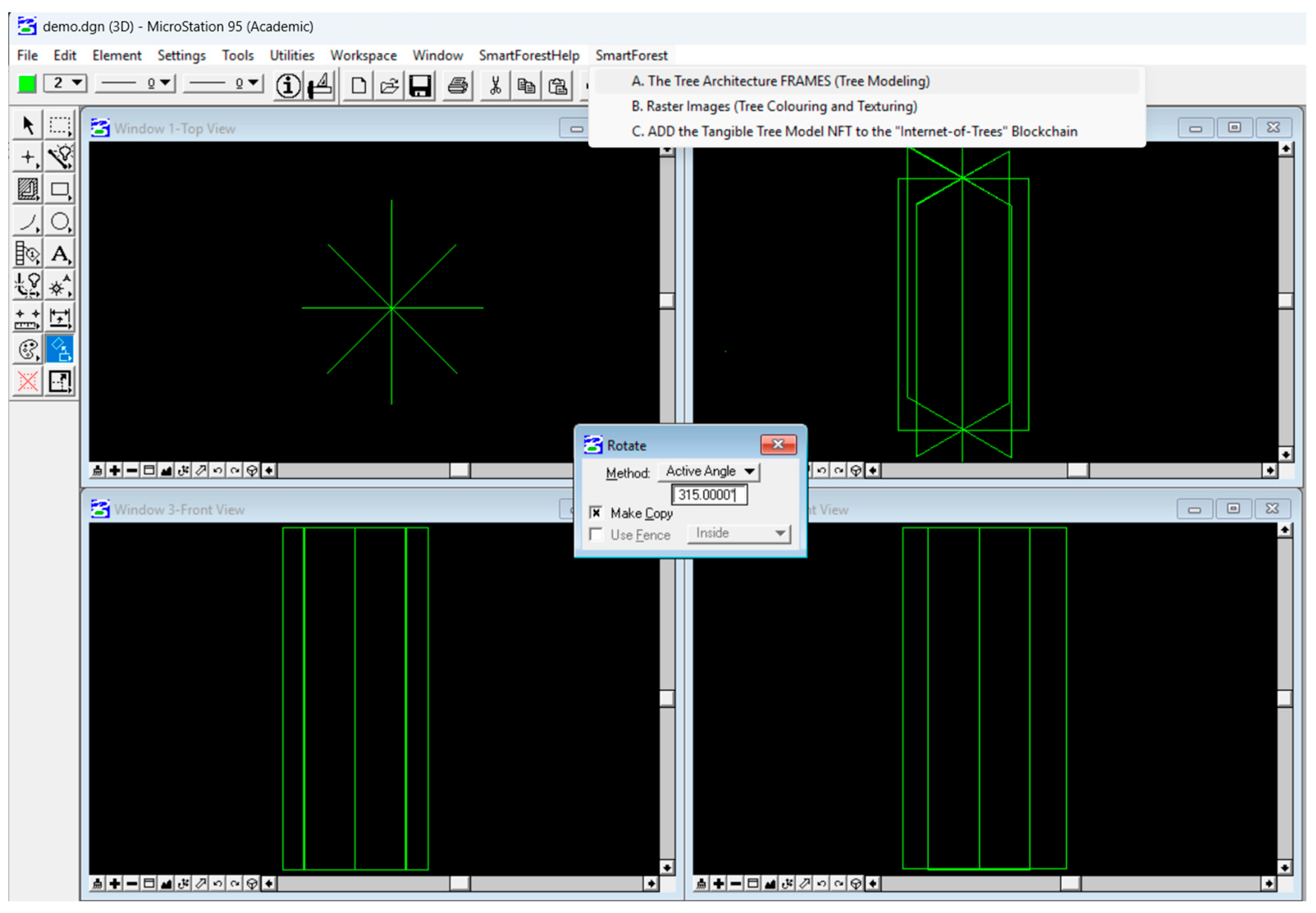
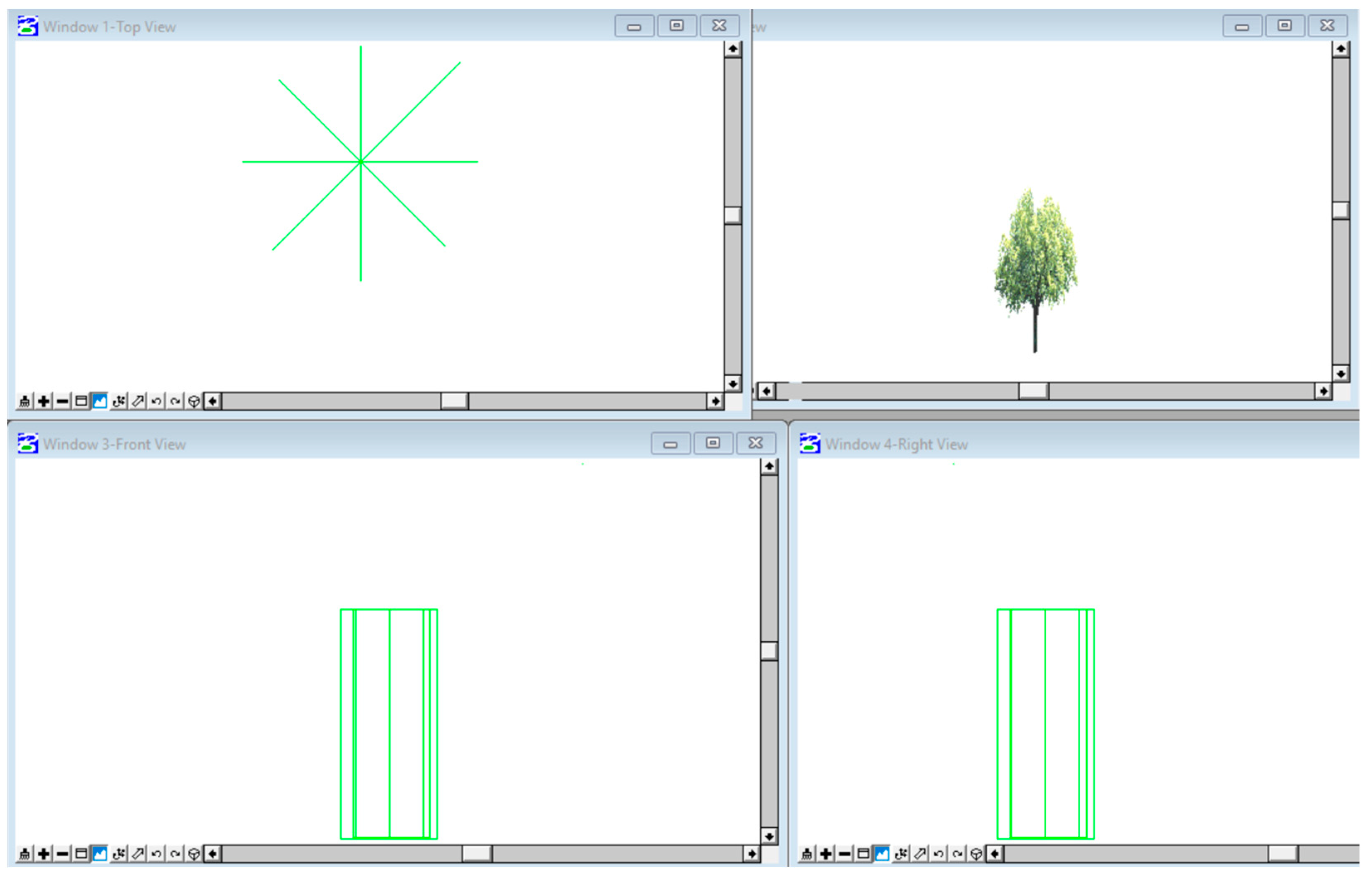
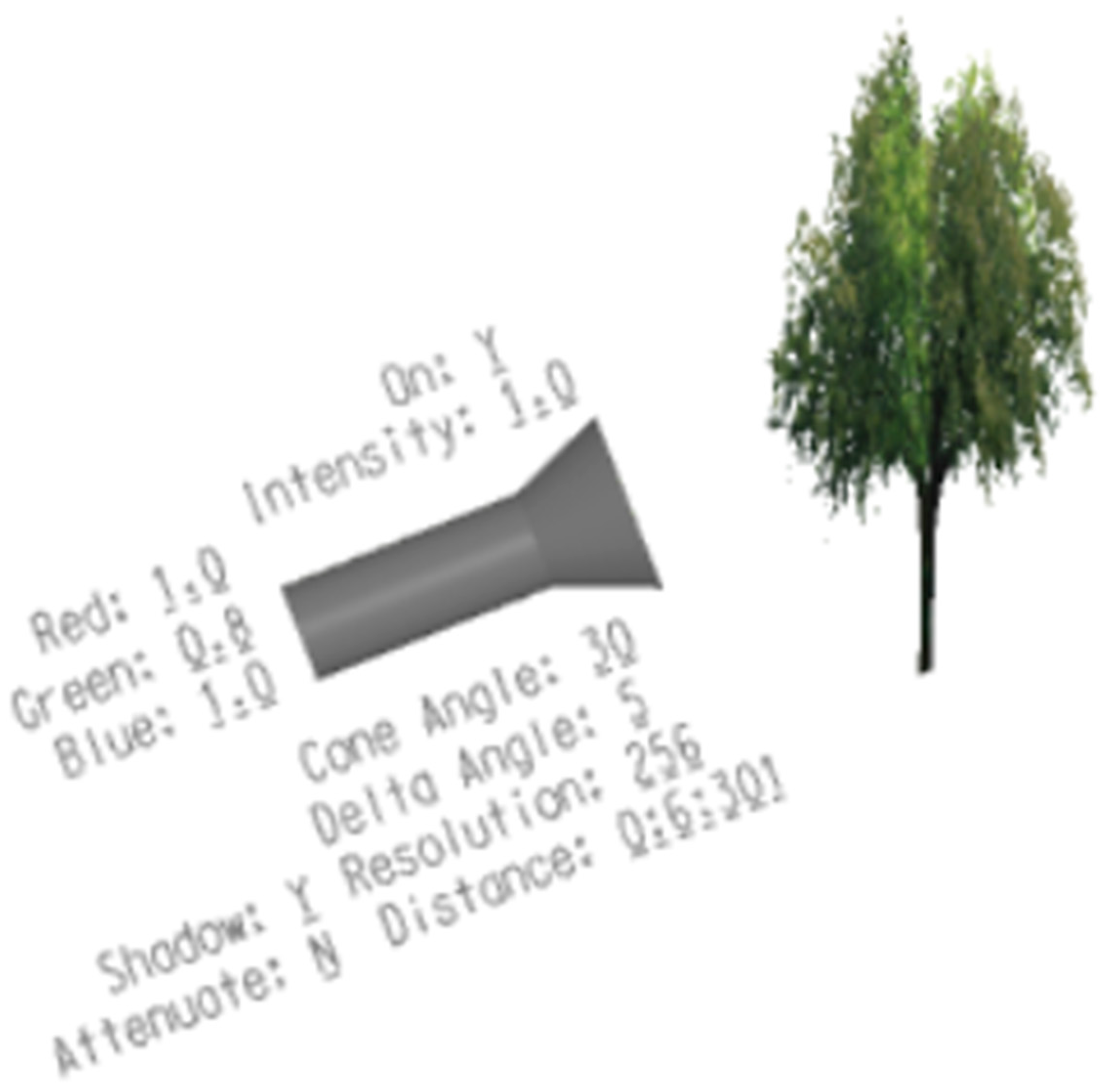
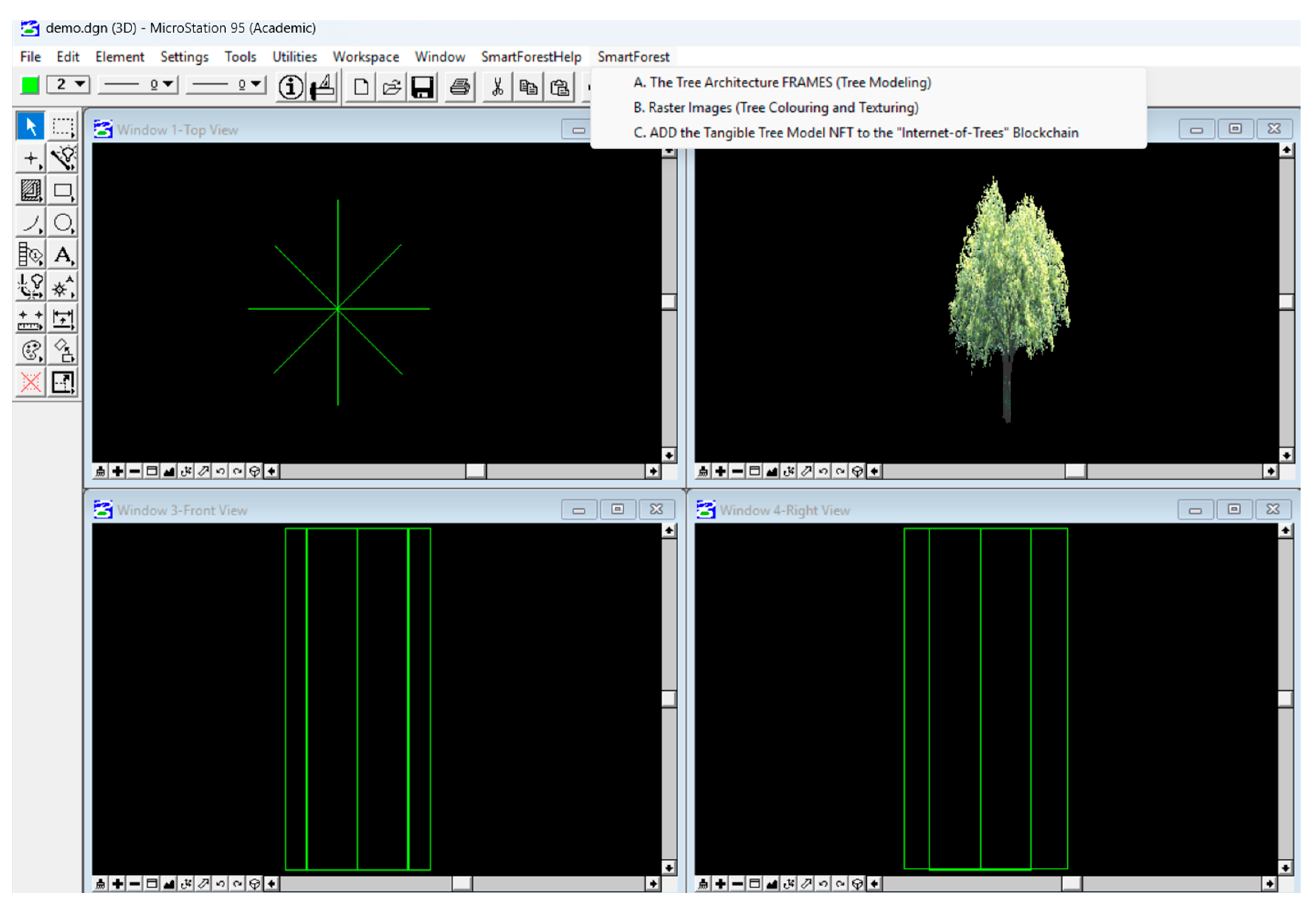

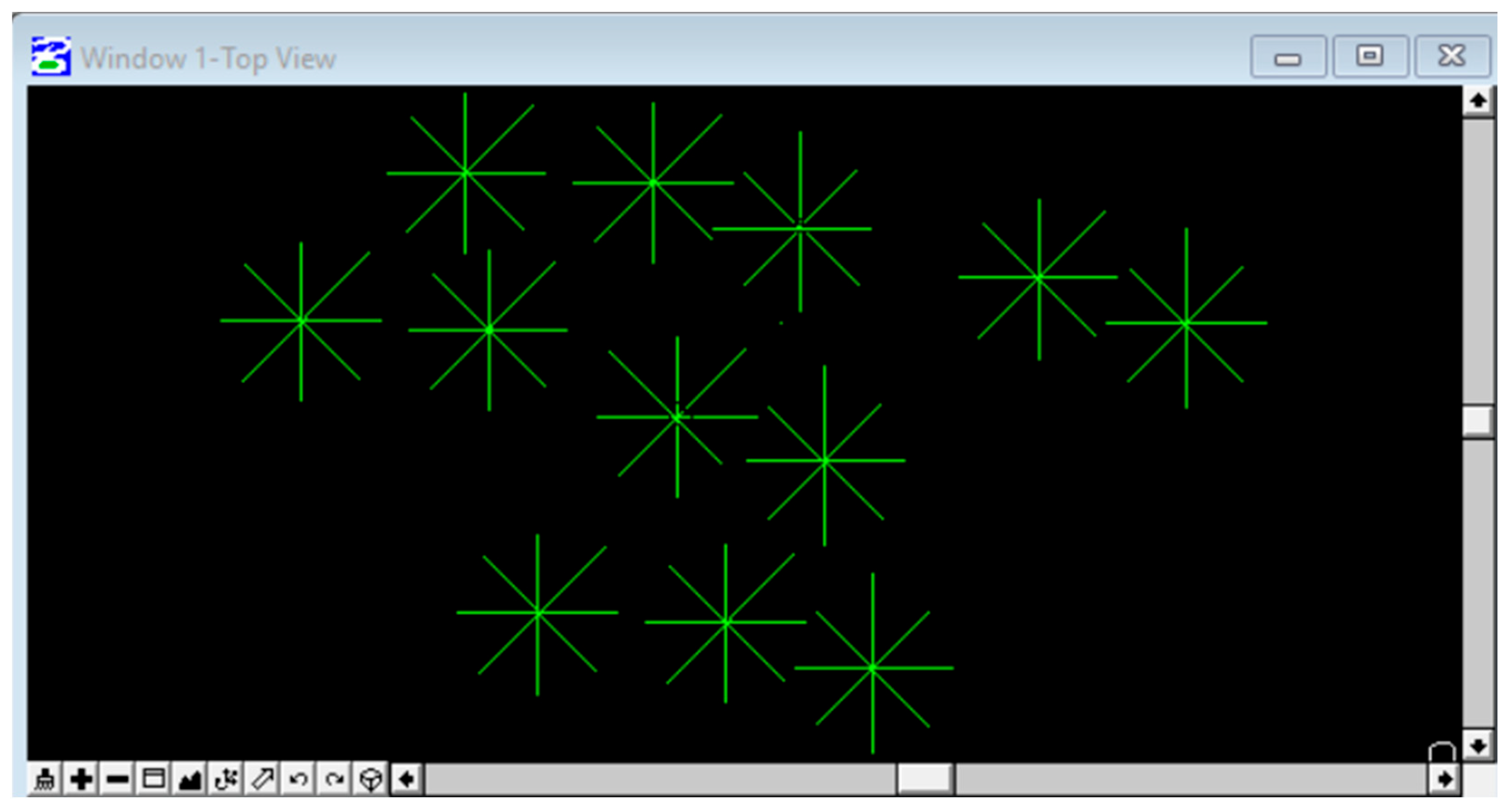
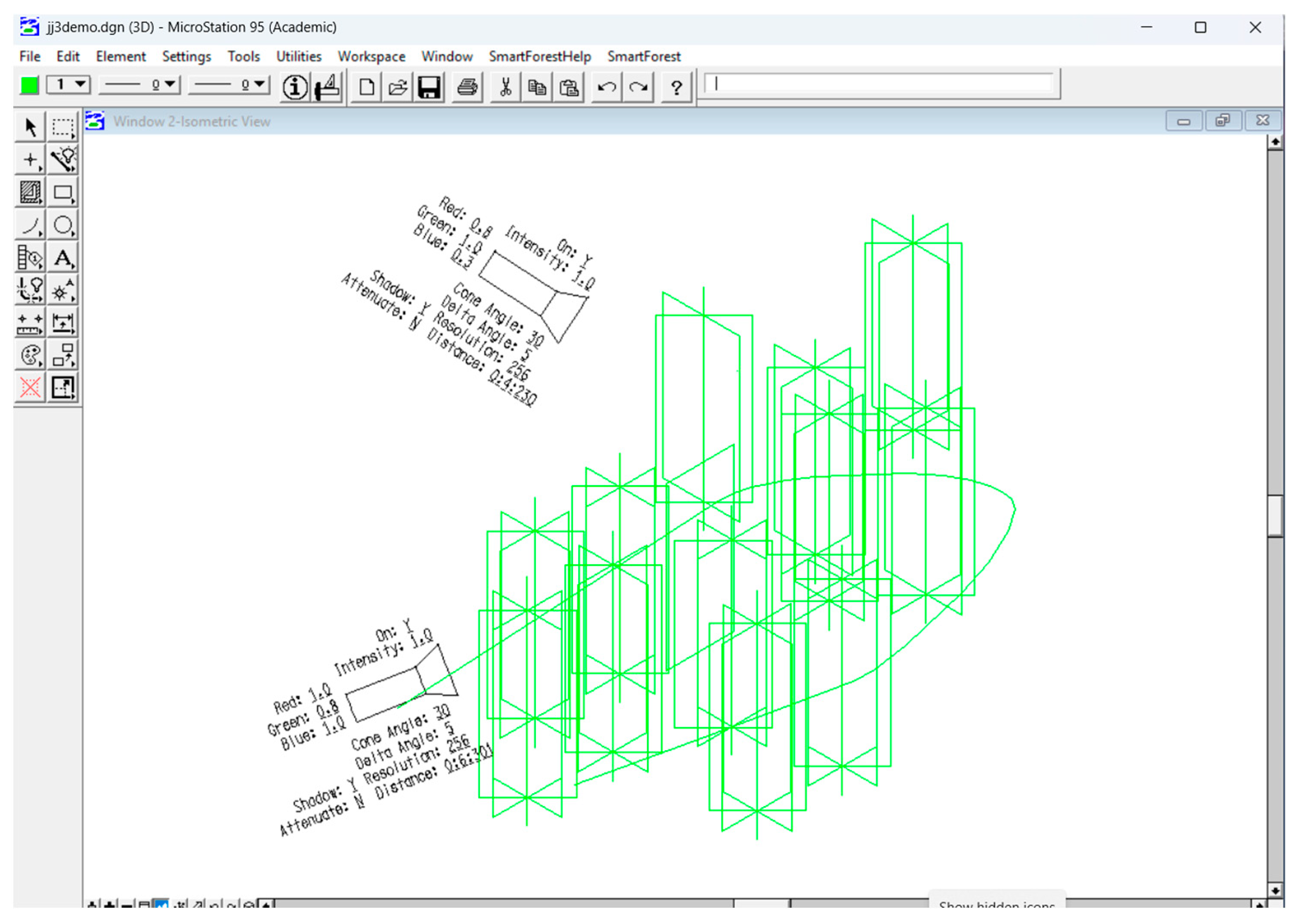
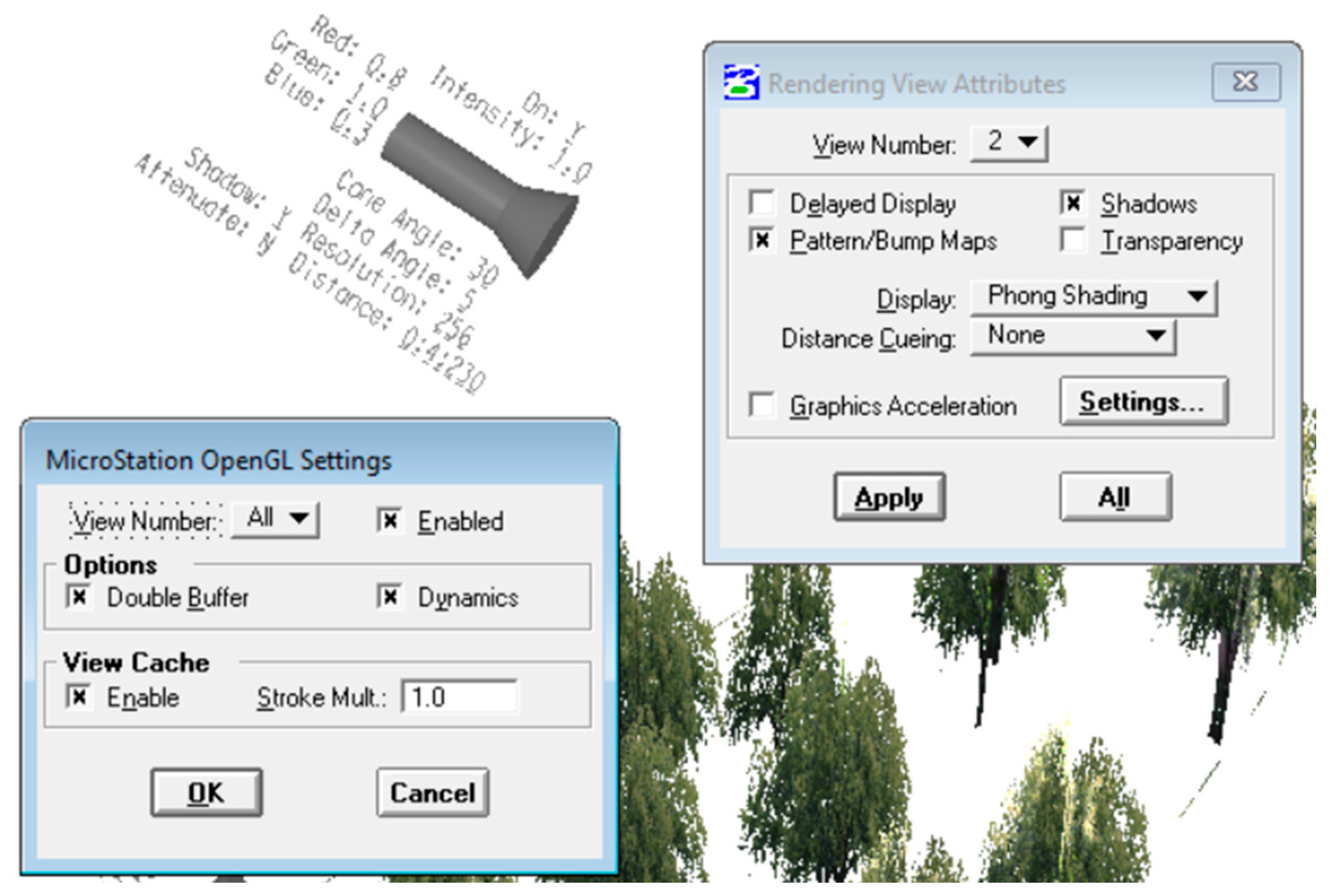
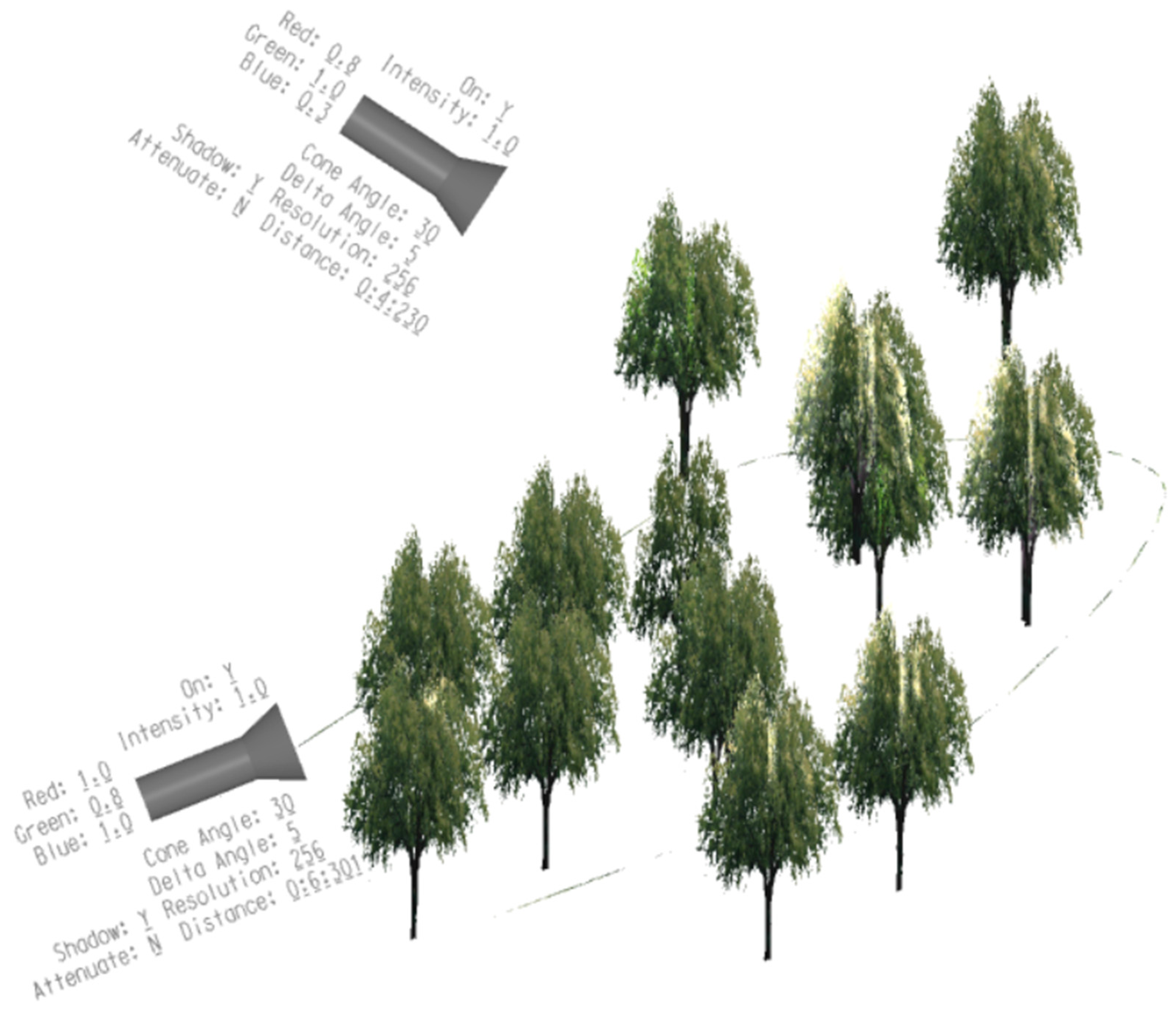
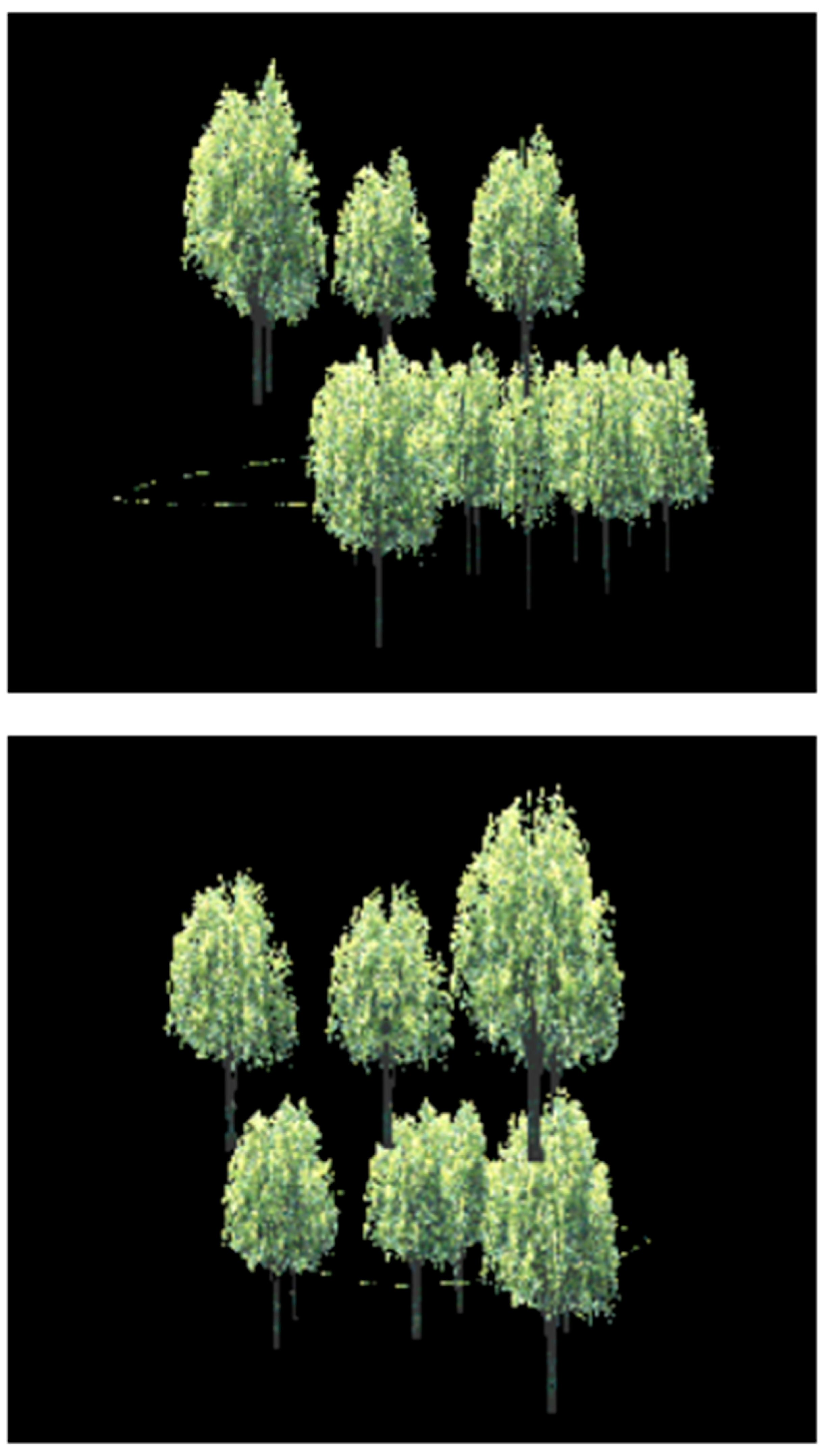



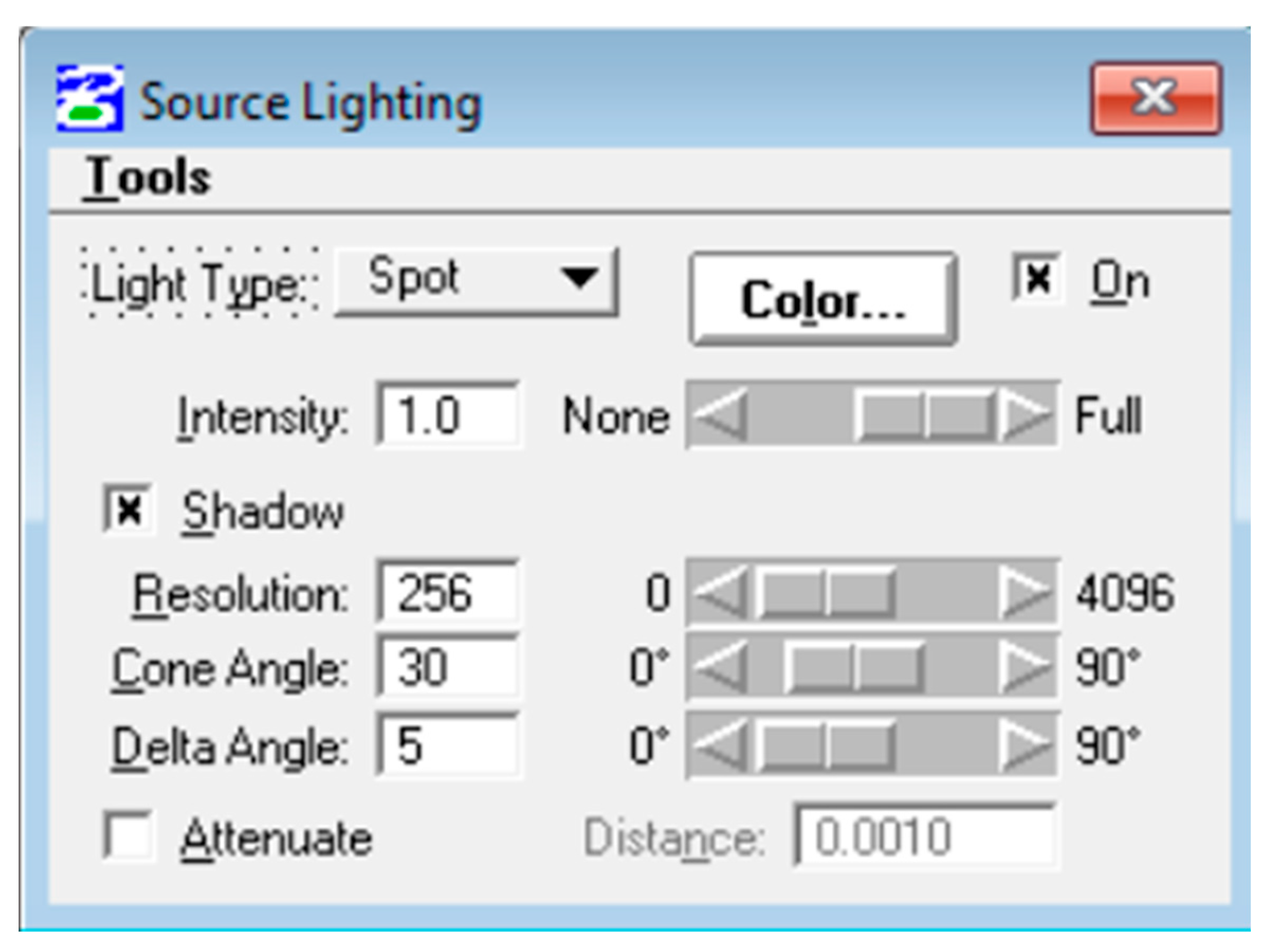
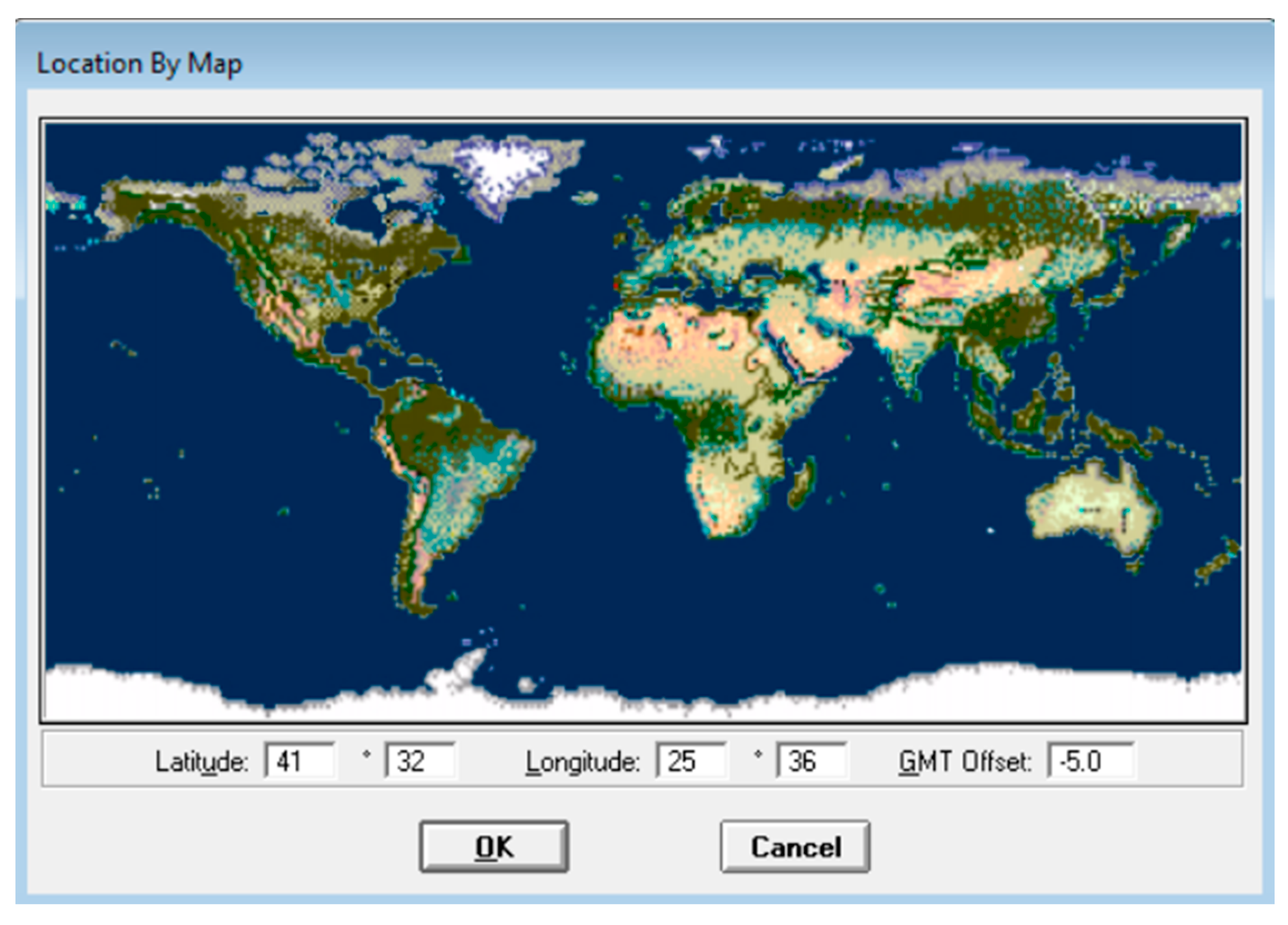
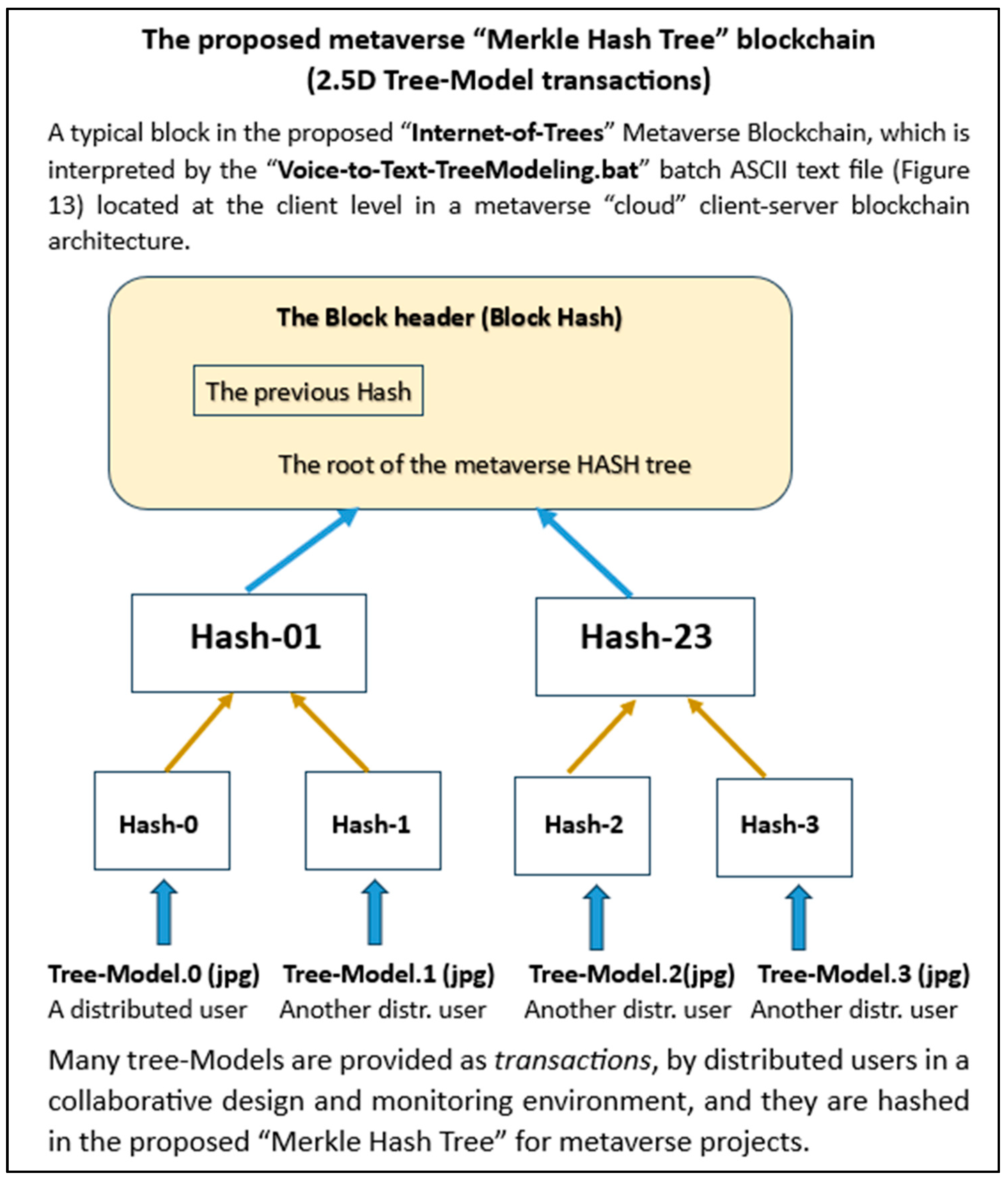
Disclaimer/Publisher’s Note: The statements, opinions and data contained in all publications are solely those of the individual author(s) and contributor(s) and not of MDPI and/or the editor(s). MDPI and/or the editor(s) disclaim responsibility for any injury to people or property resulting from any ideas, methods, instructions or products referred to in the content. |
© 2025 by the authors. Licensee MDPI, Basel, Switzerland. This article is an open access article distributed under the terms and conditions of the Creative Commons Attribution (CC BY) license (https://creativecommons.org/licenses/by/4.0/).
Share and Cite
Varveris, D.; Basdekidou, V.; Basdekidou, C.; Xofis, P. Smart Forest Modeling Behavioral for a Greener Future: An AI Text-by-Voice Blockchain Approach with Citizen Involvement in Sustainable Forestry Functionality. FinTech 2025, 4, 47. https://doi.org/10.3390/fintech4030047
Varveris D, Basdekidou V, Basdekidou C, Xofis P. Smart Forest Modeling Behavioral for a Greener Future: An AI Text-by-Voice Blockchain Approach with Citizen Involvement in Sustainable Forestry Functionality. FinTech. 2025; 4(3):47. https://doi.org/10.3390/fintech4030047
Chicago/Turabian StyleVarveris, Dimitrios, Vasiliki Basdekidou, Chrysanthi Basdekidou, and Panteleimon Xofis. 2025. "Smart Forest Modeling Behavioral for a Greener Future: An AI Text-by-Voice Blockchain Approach with Citizen Involvement in Sustainable Forestry Functionality" FinTech 4, no. 3: 47. https://doi.org/10.3390/fintech4030047
APA StyleVarveris, D., Basdekidou, V., Basdekidou, C., & Xofis, P. (2025). Smart Forest Modeling Behavioral for a Greener Future: An AI Text-by-Voice Blockchain Approach with Citizen Involvement in Sustainable Forestry Functionality. FinTech, 4(3), 47. https://doi.org/10.3390/fintech4030047








